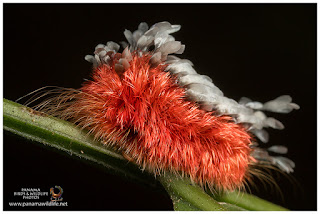This time we bring you a report from our latest macro-adventure. Joined by our collaborator Julio Abdiel Gonzalez we went to one of our most favourite places; Parque Natural Metropolitano, in Panama City.
Below you can see some of the different species we observed in the half day we spent doing macro photography.
Katydid (Tettigoniidae family)
Many katydids exhibit
mimicry and
camouflage, commonly with
shapes and colors
similar to leaves.
Crab Spider (Thomisidae family)
Crab spiders use their powerful front legs to grab and hold on to prey while paralysing it with a venomous bite
Katydid nymphs (Tettigoniidae family)
Orthopterans (order) have a generally cylindrical body, with hindlegs elongated for jumping. They have
mandibulate mouthparts for biting and chewing and
large compound eyes, and may or may not have
ocelli, depending on the species. The
antennae have
multiple joints and filiform type, and are of variable length.
Little caterpillar (Lepidoptera order)
Fly (Diptera order)
Stink bug (Pentatomoidea superfamily)
These insects in the Heteroptera suborder of the Hemiptera share a common arrangement of sucking mouthparts. They are commonly referred to as shield bugs, and stink bugs or "chinches" in Spanish. They are roughly 7000 species divided into 14 or 15 families. Shield bugs have glands in their thoraces between the first and second pair of legs which produce a foul-smelling liquid, which is used defensively to deter potential predators and is sometimes released when the bugs are handled carelessly.
Crane Fly (Tipulidae family)
The adult crane fly, resembling an oversized
mosquito, has a
slender body and
stilt-like legs that are
deciduous, easily coming off the body. The wingspan is generally about 1.0 to 6.5 cm. The antennae have up to 39 segments. It is also characterised by a V-shaped suture on the back of the
thorax and by its wing venation. The
rostrum is long; in some species it is as long as the head and thorax together.
Fly (Diptera order)
Because no species of fly has teeth or any other organ or limb that allows them to eat solid foods, flies consume only liquid food or finely granular foods, such as pollen, and their mouthparts and digestive tracts show various modifications for such diets.
Social Wasps (Hymenoptera order)
All species of social wasps construct their nests using some form of plant fibre (mostly wood pulp) as the primary material, though this can be supplemented with mud, plant secretions, and secretions from the wasps themselves; multiple fibrous brood cells are constructed, arranged in a honeycombed pattern, and often surrounded by a larger protective envelope. Wood fibres are gathered from weathered wood, softened by chewing and mixing with saliva.
Planthopper (Delphacidae family)
Jumping Spider (Lyssomanes sp.) - ♀
Lyssomanes is a spider genus of the Salticidae family (jumping spiders). Approximately 80 species have been described, ranging from South and Central America, up to the southern United States. They are long-legged, with translucent bodies frequently green or yellow. They resemble lynx spiders, except that they have large anterior median eyes.
Lynx Spider (Oxyopidae family) - ♀
Lynx spiders, in spite of being largely ambush hunters, are very speedy runners and leapers, alert and with good vision.
Jumping Spider (Salticidae family)
Spider (Araneae order) - unknown family, parasitised by mite (Acari subclass)
Barklice (Psocoptera order)
Assassin Bug (Reduviidae family)
A large cosmopolitan family of the order Hemiptera (true bugs). Though there are spectacular exceptions, most members of the family are fairly easily recognisable: they have a relatively
narrow neck, sturdy build and formidable
curved proboscis (sometimes called a
rostrum).
Weevil or Snout Beetle (Curculionoidea superfamily)
It's a type of
beetle, usually small, less than 6 mm (0.24 in), and herbivorous. Over 60,000 species are in several families, mostly in the family
Curculionidae (the true weevils).



Turtle Ant or Gliding Ant (Cephalotes atratus)
This species is the largest and one of the most common members of the genus. They are also one of the most commonly encountered Cephalotes species, in part due to their ability to thrive in urban areas. Mature colonies are comprised of several thousand individuals which can, while foraging, almost cover some tree trunks.
Firefly (Lampyridae family)
These insects in the beetle order Coleoptera, are winged, and commonly called fireflies or lightning bugs for their conspicuous use of
bioluminescence during twilight to attract mates or prey. This chemically produced light from the
lower abdomen may be yellow, green, or pale red.
Nematocera suborder
Examples of the Nematocera include the mosquitoes (Culicidae), crane flies (Tipulidae) and black flies (Simuliidae). Many of the remaining families (especially Mycetophilidae, Anisopodidae, and Sciaridae), are called
gnats, while others (especially Chironomidae, Cecidomyiidae, and Ceratopogonidae) are called
midges.
Shag-carpet Caterpillar (Prothysana folder) - larva
A species of
moth found from Mexico, south to Panama and into South America to Bolivia. Their larvae, are characterised by having
thick coats of red or buff coloured 'hair' or setae, interwoven with a carpet-like pattern in black and/or white.
Moth or Butterfly (Lepidoptera order)
Moths and butterflies are differentiated by their antennae, not visible here.































Comments
Post a Comment